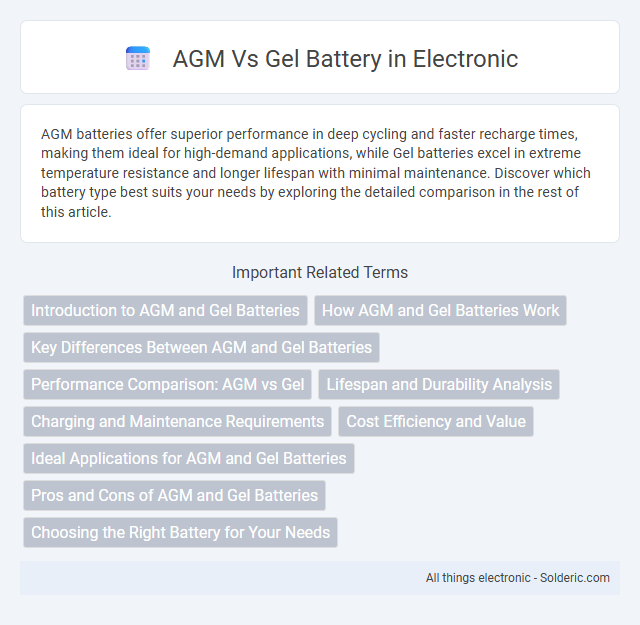AGM batteries offer superior performance in deep cycling and faster recharge times, making them ideal for high-demand applications, while Gel batteries excel in extreme temperature resistance and longer lifespan with minimal maintenance. Discover which battery type best suits your needs by exploring the detailed comparison in the rest of this article.
Comparison Table
| Feature | AGM Battery | Gel Battery |
|---|---|---|
| Electrolyte Type | Absorbed Glass Mat | Silica-based Gel |
| Charging Voltage | 13.6 - 14.4 V | 13.8 - 14.1 V |
| Discharge Depth | 50% - 80% recommended | Up to 80% recommended |
| Cycle Life | 300 - 500 cycles | 500 - 1200 cycles |
| Maintenance | Maintenance-free | Maintenance-free |
| Temperature Tolerance | Better in cold conditions | Better in high temperature environments |
| Cost | Moderate | Higher |
| Application | Start-stop vehicles, UPS systems | Renewable energy, deep cycle use |
| Weight | Lighter than Gel batteries | Heavier due to gel electrolyte |
Introduction to AGM and Gel Batteries
AGM (Absorbent Glass Mat) batteries utilize fiberglass mats to absorb electrolyte, offering low internal resistance and fast charging capabilities ideal for high-performance applications. Gel batteries contain silica to transform the electrolyte into a gel-like substance, providing enhanced resistance to vibration and deep discharge ideal for long-term, maintenance-free use. Both AGM and Gel batteries are sealed, spill-proof, and designed for reliable power storage in various renewable energy, marine, and automotive settings.
How AGM and Gel Batteries Work
AGM batteries use absorbed glass mats to hold the electrolyte in a porous separator, allowing efficient ion flow and spill-proof operation. Gel batteries contain a silica-based gel electrolyte that immobilizes the acid, providing improved resistance to vibration and deep discharge. Understanding how AGM and Gel batteries work helps you choose the right type for your energy storage needs.
Key Differences Between AGM and Gel Batteries
AGM batteries use absorbed glass mat separators to hold electrolyte in place, offering faster recharge times and better high-drain performance compared to Gel batteries, which contain silica-thickened electrolyte providing superior vibration resistance and deep discharge capabilities. Gel batteries excel in extreme temperature tolerance and longer cycle life, making them ideal for off-grid and renewable energy applications, whereas AGM batteries are favored in automotive and starting power uses due to their low internal resistance and higher burst currents. The key differences revolve around electrolyte composition, charge efficiency, discharge depth, and suitability for specific load demands and environmental conditions.
Performance Comparison: AGM vs Gel
AGM batteries deliver higher cranking power and faster recharge times compared to Gel batteries, making them ideal for applications requiring quick bursts of energy. Gel batteries exhibit superior deep-cycle performance and resistance to extreme temperatures, offering longer lifespan in harsh environments. Both battery types provide maintenance-free operation, but AGM excels in high-drain usage while Gel suits prolonged, steady power needs.
Lifespan and Durability Analysis
AGM batteries typically offer a lifespan of 3-5 years with excellent resistance to vibration and shock, making them highly durable for various applications. Gel batteries can last longer, often reaching 5-7 years, due to their sealed design and superior resistance to deep discharge and extreme temperatures. Choosing the right battery for Your needs depends on balancing lifespan expectations with durability requirements in specific operating conditions.
Charging and Maintenance Requirements
AGM batteries require a controlled charging voltage between 13.8 to 14.4 volts and are maintenance-free, making them ideal for applications needing reliable, clean power without regular upkeep. Gel batteries need a lower charging voltage, typically around 13.5 to 13.8 volts, to avoid damaging the silica-based electrolyte gel, and they also demand minimal maintenance but require careful monitoring to prevent overcharging. Understanding these charging and maintenance differences helps you optimize battery life and performance for your specific energy storage needs.
Cost Efficiency and Value
AGM batteries typically offer higher initial costs compared to Gel batteries but provide better overall cost efficiency due to longer lifespan and lower maintenance requirements. Gel batteries, while more affordable upfront, may incur higher replacement and servicing expenses over time, affecting their long-term value. Evaluating your energy needs and usage patterns helps determine which battery type delivers the best return on investment.
Ideal Applications for AGM and Gel Batteries
AGM batteries excel in high-drain applications such as automotive start-stop systems, motorhomes, and solar energy storage where rapid charging and discharging cycles occur. Gel batteries perform best in deep-cycle applications like marine use, wheelchairs, and remote telecom systems, providing reliable power with minimal maintenance in extreme temperatures. Choosing the right battery depends on your specific needs for durability, discharge rate, and environmental conditions.
Pros and Cons of AGM and Gel Batteries
AGM batteries offer faster charging times, higher discharge rates, and are more resistant to vibration, making them suitable for automotive and high-performance applications, but they tend to be less tolerant to deep discharges and can be more expensive. Gel batteries provide superior deep cycle performance, excellent resistance to extreme temperatures, and minimal maintenance due to their non-spillable design, though they have lower pulse current capabilities and longer charging periods. Choosing between AGM and Gel batteries depends on specific usage needs, such as cycling frequency, environmental conditions, and power demands.
Choosing the Right Battery for Your Needs
AGM batteries offer high discharge rates and excellent performance in cold temperatures, making them ideal for power-intensive applications like off-grid solar systems or RVs. Gel batteries provide superior deep cycling capabilities and longer lifespan, suitable for marine use and situations requiring slow, steady energy release. Your choice should consider factors like maintenance preferences, expected cycle life, and the specific energy demands of your equipment.
AGM vs Gel battery Infographic

 solderic.com
solderic.com